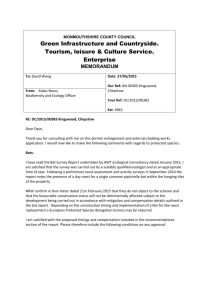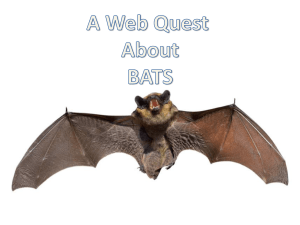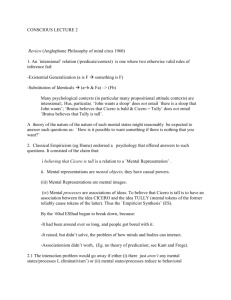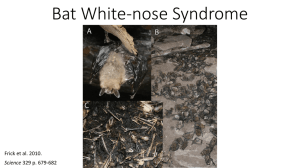Western Red Bat
advertisement
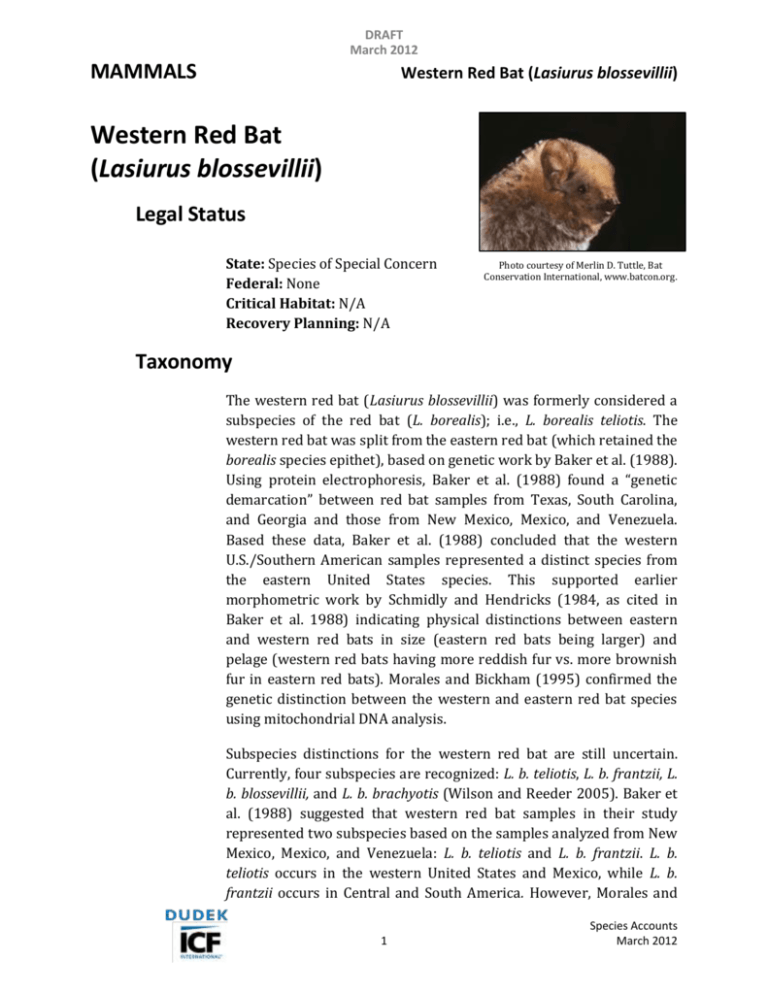
DRAFT March 2012 MAMMALS Western Red Bat (Lasiurus blossevillii) Western Red Bat (Lasiurus blossevillii) Legal Status State: Species of Special Concern Federal: None Critical Habitat: N/A Recovery Planning: N/A Photo courtesy of Merlin D. Tuttle, Bat Conservation International, www.batcon.org. Taxonomy The western red bat (Lasiurus blossevillii) was formerly considered a subspecies of the red bat (L. borealis); i.e., L. borealis teliotis. The western red bat was split from the eastern red bat (which retained the borealis species epithet), based on genetic work by Baker et al. (1988). Using protein electrophoresis, Baker et al. (1988) found a “genetic demarcation” between red bat samples from Texas, South Carolina, and Georgia and those from New Mexico, Mexico, and Venezuela. Based these data, Baker et al. (1988) concluded that the western U.S./Southern American samples represented a distinct species from the eastern United States species. This supported earlier morphometric work by Schmidly and Hendricks (1984, as cited in Baker et al. 1988) indicating physical distinctions between eastern and western red bats in size (eastern red bats being larger) and pelage (western red bats having more reddish fur vs. more brownish fur in eastern red bats). Morales and Bickham (1995) confirmed the genetic distinction between the western and eastern red bat species using mitochondrial DNA analysis. Subspecies distinctions for the western red bat are still uncertain. Currently, four subspecies are recognized: L. b. teliotis, L. b. frantzii, L. b. blossevillii, and L. b. brachyotis (Wilson and Reeder 2005). Baker et al. (1988) suggested that western red bat samples in their study represented two subspecies based on the samples analyzed from New Mexico, Mexico, and Venezuela: L. b. teliotis and L. b. frantzii. L. b. teliotis occurs in the western United States and Mexico, while L. b. frantzii occurs in Central and South America. However, Morales and 1 Species Accounts March 2012 DRAFT March 2012 MAMMALS Western Red Bat (Lasiurus blossevillii) Bickham (1995) found no genetic difference between L. b. teliotis and L. b. frantzii from Belize in Central America, indicating that this distinction is misleading or could represent genetic exchange between these two subspecies. They recommended that the western United States, Mexico and Central American populations be assigned to the subspecies L. b. frantzii and that the South American subspecies L. b. blossevillii could be recognized as a separate species based on genetic differences. L. b. brachyotis is endemic to the Galapagos Islands. However, as noted previously, the four subspecies listed are still in place (Wilson and Reeder 2005). Despite the uncertainty about the western red bat subspecies, the full western red bat species is designated a California Species of Special Concern (CDFG 2011a), so these taxonomic issues are not critical to the Desert Renewable Energy Conservation Plan (DRECP). A physical description for red bats is provided by Shump and Shump (1982). However, this description was written for the red bat before the western red bat was split from the eastern red bat. Schmidly and Hendricks (1984, as cited in Baker et al. 1988) noted that western populations were smaller than eastern populations and had rusty-red dorsal fur compared to the more brown dorsal coloration in the eastern red bat. Distribution General The western red bat occurs in southern British Columbia, the western United States, Mexico, Central Mexico, and possibly South America (Cryan 2003; Pierson et al. 2006) (Figure SP-M10). Cryan (2003) suggests that there may be areas of overlap with the eastern red bat in western Texas, New Mexico, and Mexico. Although the species has a wide range, relatively few records for the western red bat exist outside of California (Pierson et al. 2006). In California, most of the records are from the Central Valley, which is the breeding center for the western red bat in the state. About 83% of the breeding records for western red bat in California are from the Sacramento and San Joaquin rivers, with other breeding records from the San Diego, Santa Ana, and Los Angeles rivers (Pierson et al. 2006). 2 Species Accounts March 2012 DRAFT March 2012 MAMMALS Western Red Bat (Lasiurus blossevillii) Although the Central Valley is the center of activity during the reproductive season (May through August), western red bats occur throughout low elevations of California. Individuals appear to stay in California year-round because there are occurrence records for every month of the year (Pierson et al. 2004). There is evidence for seasonal movements by western red bats in California, but little evidence for mass migrations characteristic of the eastern red bat and other tree bats such as the hoary bat (Lasiurus cinereus) (Cryan 2003; Pierson et al. 2006). The northern extent of the species’ summer range in California appears to be Humboldt County. Kennedy (2011) recorded the first occurrences of western red bat in the redwood forest in Humboldt County about 50 kilometers (31 miles) north of the species’ suspected range, but only two calls were detected in almost 18 months of continuous recording, indicating its rarity in the area. The distributions of males and females in California differ seasonally. Males are dispersed throughout the state during the reproductive season, while females are concentrated in the Central Valley (Pierson et al. 2006). During the non-reproductive season, both males and females in California are more dispersed, with 54% of the records along the coast south of Humboldt County, 24% in the Central Valley, and 21% in Southern California (Pierson et al. 2006). Winter records are mostly from areas that rarely freeze. Most records are from elevations below 200 meters (656 feet) (Pierson et al. 2006). There are scattered records for the western Sierra Nevada foothills, and records from higher elevations (a maximum of 2,484 meters [8,150 feet]) are most likely for males (Pierson et al. 2006). Distribution and Occurrences within the Plan Area Historical There are very few records for western red bat in the desert regions of California. Pierson et al. (2006) report two records for Death Valley, one in the Bishop area of the Owens Valley, a breeding record for the Twentynine Palms area, and one in Nevada, east of the White Mountains. There are no historical (i.e., pre-1990) California Natural Diversity Database (CNDDB) records for the western red bat in the Plan Area (CDFG 2011b). 3 Species Accounts March 2012 DRAFT March 2012 MAMMALS Western Red Bat (Lasiurus blossevillii) Recent There are no recent (i.e., since 1990) CNDDB (CDFG 2011b) or other records for western red bat in the Plan Area. Natural History Habitat Requirements The western red bat, as a tree bat, is closely associated with welldeveloped riparian habitats that provide suitable roosting sites. Pierson et al. (2006) conducted acoustic and selected mist netting surveys at potential roosting sites in the Central Valley. Most of the sample locations were along the Sacramento and San Joaquin rivers, as well as tributaries and some other selected sites with suitable habitat. At each site they assigned the riparian habitat to one of three categories: (A) Fremont cottonwood (Populus fremontii)/western sycamore (Platanus racemosa) and/or valley oak (Quercus lobata) in zones at least 50 meters (164 feet) wide; (B) mature trees but only two or three trees wide; and (C) one tree and secondary growth/young trees in sparsely vegetated riparian strips. They also had a fourth non-riparian category: (D) grass/shrubs more than 100 meters (328 feet) to nearest trees. Western red bats were detected wherever there was suitable riparian habitat, but most of the detections were in the “A” category. Pierson et al. (2006) also observed foraging along gravel bars within rivers, but only where the gravel bars were at least 50 meters (164 feet) wide and several hundred meters long. Notably, western red bat densities peaked in July and August and then declined in the fall, presumably when bats were moving to winter sites. Along the lower Colorado River, cottonwood-willow (Salix spp.) riparian habitat and honey mesquite (Prosopis glandulosa) are considered suitable roosting and foraging habitats for migrating and potentially year-round residents in the area (Lower Colorado River Multi-Species Conservation Program (LCR MSCP 2004); however, no western red bat records exist for the LCR MSCP planning area. Although Pierson et al. (2006) determined that western red bats differentially select wide, well-developed riparian habitats with 4 Species Accounts March 2012 DRAFT March 2012 MAMMALS Western Red Bat (Lasiurus blossevillii) mature trees (i.e., A-category habitats) over more narrow zones and young trees for breeding roosts (i.e., B- and C-category habitats), the species frequently has been observed using non-native trees for roosting. Western red bats have been observed in orchard trees, including fig (Ficus carica), apricot (Prunus armeniaca), peach (Prunus persica), pear (Pyrus communis), almond (Prunus amygdalus), walnut (Juglans regia), and orange trees (Citrus sinensis) (Benson 1945, as cited in Pierson et al. 2006; Constantine 1959; Grinnell 1918, as cited in Pierson et al. 2006; Pierson et al. 2006). They have also been observed to use other non-native trees, including African hemp (Sparmannia Africana), eucalyptus (Eucalyptus spp.), Chinaberry (Melia azedarach), mulberry (Morus rubra), and tamarisk (Tamarix spp.)(Constantine 1959; Dalquest, as cited in Pierson et al. 2006; Grinnell 1918, as cited in Pierson et al. 2006; Orr 1950; Pierson et al. 2006). The use of orchards and potential exposure to pesticides is discussed in Threats and Environmental Stressors. There is little information about roost site characteristics favored by the western red bat (e.g., microclimates, cover density, tree aspect) because most of the ecological studies have been carried out in the east within the range of the eastern red bat. Pierson et al. (2006) hypothesize that western red bats roost in the canopy of the largest trees, based on data for eastern red bats, but note that western red bat habitat associations are very different from the more common eastern red bat. Tree roosting bats in general are more exposed to ambient temperatures than cave, rock, and mine dwelling species; therefore, physical, physiological, and/or behavioral adaptations to more extreme conditions would be expected. Davis and Lidicker (1956) reported that eastern red bats hibernate, but this adaptation to cold temperatures may not apply to western red bat. However, like eastern red bats, western red bats have thick fur and rounded ears, which indicate adaptations to cold conditions. Based on the apparent habitat requirements of western red bats for breeding and the fact that the vast majority of breeding records for the species are in the Central Valley, it is unlikely that western red bat breeds in much of the Plan Area. However, it may be a resident in the lower Colorado River area (LCR MSCP 2004). The species may also 5 Species Accounts March 2012 DRAFT March 2012 MAMMALS Western Red Bat (Lasiurus blossevillii) winter in suitable riparian habitats in the Plan Area, particularly along the lower Colorado River. Potential habitats supporting the western red bat in the Plan Area are listed in Table 1. Table 1. Habitat Associations for Western Red Bat Land Cover Type Forest, woodland, riparian, mesquite bosque Habitat Designation Winter roosting, foraging Habitat Parameters Forest, woodland, riparian, mesquite bosque Supporting Information Pierson et al. 2006, LCR MSCP 2004 Foraging Requirements The foraging information provided in this section is for the red bat, as summarized by Shump and Shump (1982) prior to its split into two species, and mostly reflects data for eastern populations. It is assumed for the purpose of this profile that the information is generally applicable to the western red bat. Red bats appear to select prey by size rather than taxonomic groups (e.g., in contrast to bats that are moth specialists). They feed on a variety of prey, including Lepidoptera (moths), Homoptera (e.g., cicadas, leaf hoppers), Coleoptera (beetles), Hymenoptera (wasps), Diptera (flies), and Orthoptera (crickets, grasshoppers) (Shump and Shump 1982). Red bats usually emerge to forage 1 to 2 hours after sunset and may forage for several hours during a primary foraging bout, and again later in the night during a secondary bout. LaVal and LaVal (1979) reported late afternoon foraging activity in Missouri, but this activity appears to be uncommon even though it has also been reported by others (Davis and Lidicker 1956; Barbour and Davis 1969 and Whitaker and Mumford 1972, as cited in La Val and LeVal 1979). Their foraging activity may be timed in relation to the foraging behavior of other bat species and the early nocturnal activity of their insect prey (see Ecological Relationships). Red bats appear to forage in the same areas over time, but there is little information about spatial foraging patterns. Red bats become active at temperatures of about 20 degrees Celsius (68 degrees Fahrenheit), but have been observed flying at temperatures as low as 7 degrees Celsius (44.6 degrees Fahrenheit) (LaVal and LaVal 1979; Shump and Shump 1982). LaVal and LaVal 6 Species Accounts March 2012 DRAFT March 2012 MAMMALS Western Red Bat (Lasiurus blossevillii) (1979) observed red bats in Louisiana and Missouri foraging in a variety of habitats, including along streams and rivers, gravel bars, riparian areas, floodplains, and hill forests. Pierson et al. (2006) also observed western red bats flying along wide gravel bars in California. They are often observed feeding in large numbers at lights that attract insects (e.g., LeVal and LeVal 1979). Reproduction As with foraging requirements, information about reproduction is primarily for the red bat, and may be somewhat different for the western red bat in association with their different ecological setting and potentially different seasonal activity patterns. Breeding occurs in August and September (Shump and Shump 1982). Females store the sperm, and fertilization occurs in the spring. Gestation is estimated to be 80 to 90 days. Litter sizes are relatively large for bats (as is characteristic of solitary tree bats compared to colonial bats), with an average of about 2.3 young, and litters as large as 5 young (Hamilton and Stalling 1972; LaVal and LaVal 1979; Shump and Shump 1982). The young are relatively undeveloped at birth; they are hairless and their eyes are closed. They are weaned by 4 to 6 weeks and fly between 3 and 6 weeks (Shump and Shump 1982). Key seasonal periods for western red bat are summarized in Table 2. 7 Sep Oct Nov Dec Reproduction x x x Seasonal Movements/ Wintering x x x x ________________ Notes: There is no evidence for mass migration. Sources: Pierson et al. 2006; Cryan 2003. Aug July June May April March Feb Jan Table 2. Key Seasonal Periods for Western Red Bat x x x x x Species Accounts March 2012 DRAFT March 2012 MAMMALS Western Red Bat (Lasiurus blossevillii) Spatial Activity As described previously under Distribution, western red bats appear to make seasonal movements in California, but there is little evidence for mass migrations (Cryan 2003; Pierson et al. 2006). Breeding females appear to leave summer sites by September (Pierson et al. 2006), the time period in which males and females come together for breeding. As noted under Distribution, males are much more dispersed in California during the spring/summer reproductive season. How far individual western red bats move is unknown, but it is expected to be at least several hundred miles given that populations in southern and coastal California expand in the winter; presumably individuals moving to southern California include females that breed in the Central Valley. In addition, western red bats have a relatively low wing load and are relatively fast fliers (Shump and Shump 1982); therefore, seasonal movement of several hundred miles is plausible. No information is available for spatial patterns related to foraging activities (e.g., what are nightly flight distances, do they exhibit centers-of-activity, and do they spatially partition foraging areas with other bat species?). Pierson et al. (2006) observed western red bat activity over wide gravel bars and along the edges of riparian habitat, but little activity over “denuded” river banks (i.e., grass or riprap). Pierson et al. (2006) recommend radiotelemetry studies of this species to better understand its behavior, especially with regard to conservation and management activities. Ecological Relationships Pierson et al. (2006) recorded up to 13 other bat species at sites where western red bats were documented in the Central Valley (see Table 3 in Pierson et al. 2006). This high diversity of bats indicates that the well-developed riparian habitats used by western red bats are also high value habitat for other species, including roosting habitat for other tree bats such as silver-haired bat (Lasionycteris noctivagans) and hoary bat, and foraging habitat for other insectivorous bats. Western red bat usually was not the most abundant species at sites, but it was one of the most widely encountered across the habitats sampled by Pierson et al. (2006), exceeded only by the Mexican free-tailed bat (Tadarida brasiliensis). 8 Species Accounts March 2012 DRAFT March 2012 MAMMALS Western Red Bat (Lasiurus blossevillii) Black (1974) suggested that bats may employ several types of foraging and food partitioning mechanisms that could reduce inter-specific competition, including size and type of prey; periods of activity (most bat prey are active within a few hours of sunset, but different prey have different peak activity periods); spatial partitioning, such as between-, within-, and below-canopy foragers; and flight patterns, such as slow vs. fast flying, maneuverability, and hovering. At one site, Pierson et al. (2006) observed initial, intense foraging by big brown bat (Eptesicus fuscus) and a Myotis species, followed 15 minutes later by western red bats as the dominant species, appearing suddenly from the tree canopy. Otherwise, the Pierson et al. (2006) study did not address temporal or other potential resource partitioning strategies among the different bat species. Kunz (1973) found temporal associations between red bat and other bats in Iowa, with the red bat foraging in the earliest period (1-2 hours after sunset), followed by silver-haired bat (3-4 hours after sunset), and hoary bat (4-5 hours after sunset). Kunz (1973) suggested that earlier activity of red bats was correlated with the activity of a variety of insect prey and the later activity of hoary bats corresponded to the availability of moths, its preferred prey. Kunz (1973) also noted spatial separation of red bats and hoary bats; where red bats are common, hoary bats are less common, and vice versa. Whether these kinds of resource partitioning mechanisms apply to the bat communities in California is unknown. As noted previously in Foraging Requirements, red bats are often observed foraging at artificial lights. Artificial lighting may affect competitive predator-prey relationships among bats. Longcore and Rich (2004) suggest that artificial lighting, which attracts many insects taken by bats, including moths (Frank 1988), may alter local community relationships because the faster-flying bats congregate around lights and can exploit this concentrated food source while slower-flying bats avoid lights and are unable to benefit from this concentration of insects. Hickey et al. (1996) found that red bats and hoary bats foraging at the same street lights at a site in Ontario, Canada, take prey of different size classes, with the smaller red bat (half the size of the hoary bat) taking smaller prey, indicating possible resource partitioning at these artificial foraging sites. 9 Species Accounts March 2012 DRAFT March 2012 MAMMALS Western Red Bat (Lasiurus blossevillii) Population Status and Trends Global: Secure (NatureServe 2011) State: Vulnerable (?) (CDFG 2011a) Within Plan Area: Unknown Western red bat is a California Species of Special Concern, but its population status and trends within its range in the western United States and within California are unknown. However, Pierson et al. (2006) noted that there were relatively few, scattered records for the species outside of California. Their review found only two records for British Columbia, Canada, none for Washington and Oregon, four for Utah, and less that 12 each for Arizona and New Mexico. Based on a recommendation by Pierson et al. (2006), the western red bat was designated a California Species of Special Concern. This recommendation was based on the fact that the western red bat was split from the eastern red bat, elevating the concern for its conservation within its more restricted range and limited riparian habitats in the western United States. Additionally, the breeding stronghold for this species in California is in the Central Valley, along the Sacramento and San Joaquin drainages and other large rivers that drain the Sierra Nevada (Pierson et al. 2006). The large riparian zones within these drainages have historically been subjected to loss and degradation, reducing high quality roosting and foraging habitat available to the species. Nonetheless, Pierson et al. (2006) did find the species at all suitable habitat sites in their sample area, and it does use non-native tree species for roosting, indicating that it is not imminently threatened, thus reflecting its designation as possibly vulnerable in California (CDFG 2011a). Threats and Environmental Stressors The primary threat to western red bat is loss and degradation of welldeveloped riparian zones that support larger, mature trees such as Fremont’s cottonwood, western sycamore, and valley oak within the Central Valley and elsewhere along major rivers and tributaries. Pierson et al. (2006) also express concern that pesticide use at occupied orchards could harm western red bats, either through direct poisoning or indirectly through impacts on prey abundance, especially if the bats are using the orchards as compensation for the historical loss of native 10 Species Accounts March 2012 DRAFT March 2012 MAMMALS Western Red Bat (Lasiurus blossevillii) riparian habitats (particularly walnut orchards along the Sacramento River). Pierson et al. (2006) suggest that if pesticides adversely affect western red bats, the orchards may function as “sink’ habitat. Human activities may also affect roosting and reproduction, especially if pregnant and lactating females are roosting in orchards subject to high levels of human activity. Constantine (1959) reported that human activities in orchards caused bats to fly from the roosts, although they returned the next day. Human talking and walking around roost sites did not appear to substantially disturb bats, but any attempt to handle the bat did. It is expected that active work in the trees such as pruning and harvesting would adversely affect roosting individuals and potentially disrupt reproduction (e.g., tending of young during early development phases). Prior to the 2000s, fewer than 200 bat fatalities due to collisions with artificial structures had been documented (Cryan 2011). Since the late 1990s, bat fatalities, primarily related to wind energy facilities, have dramatically increased (Cryan 2011; Kunz et al. 2007). The migratory tree bats—red bats, hoary bats, and silver-haired bats—make up the majority of fatalities (Arnett et al. 2005), with eastern red bat comprising about 20% of all documented fatalities to date (Cryan 2011). The number of bat fatalities attributed to wind energy facilities is very high, with an estimate of up to 450,000 per year (Cryan 2011). For example, between 1,500 and 4,000 bats were estimated to have died at a single wind energy site during 2004 (Cryan 2011). However, fatality rates are highly variable, and estimates for individual wind facility sites have ranged from just below one bat per installed megawatt per year (bats/MW/yr) to as high as 70 bats/MW/yr (Cryan 2011). The highest bat fatalities appear to occur where facilities are built on ridge tops (Johnson and Erickson 2008). In the western United States in Washington and Oregon, bat fatalities at wind energy facilities have been similar to other parts of the country. Bat fatality estimates for the Columbia Plateau Ecoregion (CPE) were made for 10 existing wind facilities and ranged from 0.39 to 2.46 fatalities/MW/yr, with an average of 1.18 fatalities/MW/yr (Johnson and Erickson 2008). However, no fatalities of western red bats were documented in this study even though the CPE is within the range of the species. 11 Species Accounts March 2012 DRAFT March 2012 MAMMALS Western Red Bat (Lasiurus blossevillii) Red bat fatalities from collisions with tall buildings in New York and Chicago (Terres 1956; Timm 1989, as cited in Cryan 2011) and a television tower in Kansas (Van Gelder 1956, as cited in Cryan 2011) have also been documented. Cryan (2011) suggests that there may be something about the behavior of tree bats that makes them more vulnerable to collisions, such as the seasonality and pattern of migrations. Johnson and Erickson (2008) assume that the hoary bat fatalities in the CPE are of individuals migrating from breeding habitat in the surrounding mountainous/forested ecoregions or from more northern areas in Canada, but that the dynamics of these populations would need to be known to predict population effects. As noted above, no fatalities of western red bats have been documented in the CPE. Conservation and Management Activities The western red bat is a Covered Species under the LCR MSCP (2004). Although the species has not been recorded in the LCR MSCP planning area, it is thought to migrate through the area and may be a yearround resident (see Appendix I, Status of LCR MSCP Covered Species, in LCR MSCP 2004). The LCR MSCP identifies cottonwood-willow habitat and honey mesquite as suitable roosting and foraging habitat for western red bat. One of the conservation measures in the LCR MSCP is to provide replacement riparian habitat that would benefit western red bat, including removal of tamarisk and replacement with suitable native habitat. The LCR MSCP conservation goal for western red bat is to create 765 acres of roosting habitat, defined as cottonwood-willow and honey mesquite. In addition, this habitat will be monitored and managed, and surveys for western red bat will be conducted to identify habitat requirements and the species’ distribution in the MSCP area. Data Characterization There are virtually no current data for western regarding its distribution and habitat use in the Plan Area, including seasonal movements and roosting sites. Because it is expected to migrate through the lower Colorado River area and possibly be a year-round 12 Species Accounts March 2012 DRAFT March 2012 MAMMALS Western Red Bat (Lasiurus blossevillii) resident, the LCR MSCP (2004) provides coverage for the species and identifies suitable habitat as cottonwood-willow and honey mesquite. Management and Monitoring Considerations The main management consideration for western red bat is maintaining large, wide riparian zones (i.e., greater than 50 meters [164 feet] wide) with mature trees (e.g., cottonwoods in desert regions) (Pierson et al. 2006). Pesticide use in agricultural areas adjacent to suitable roosting and foraging areas should be managed to prevent direct poisoning and secondary impacts on prey. Human activities near active roosting sites should be curtailed to prevent disturbance. Predicted Species Distribution in Plan Area Modeled suitable habitat included the riparian community in the Plan Area. There are 75,262 acres of modeled suitable habitat for western red bat in the Plan Area. Appendix C includes specific model parameters and a figure showing the modeled suitable habitat in the Plan Area. Species model summary and results will be provided following model development. Literature Cited Arnett, E.B., W.P. Erickson, J. Kerns, and J. Horn. 2005. Relationships between Bats and Wind Turbines in Pennsylvania and West Virginia: An Assessment of Fatality Search Protocols, Patterns of Fatality, and Behavioral Interactions with Wind Turbines. Final report prepared for the Bats and Wind Energy Cooperative. June 2005. Baker, R.J., J.C. Patton, H.H. Genoways, and J.W. Bickham. 1988. “Genic Studies of Lasiurus (Chiroptera: Vespertilionidae).”Occasional Papers, The Museum, Texas Tech University 117:1–15 Black, H.L. 1974. “A North Temperate Bat Community: Structure and Prey Populations.” Journal of Mammalogy 55(1):138–157. CDFG (California Department of Fish and Game). 2011a. “Special Animals (898 taxa).” California Natural Diversity Database. CDFG, 13 Species Accounts March 2012 DRAFT March 2012 MAMMALS Western Red Bat (Lasiurus blossevillii) Biogeographic Data Branch. January 2011. Accessed November 21, 2011. CDFG). 2011b. “Lasiurus blossevillii.” Element Occurrence Query. California Natural Diversity Database (CNDDB) species. RareFind, Version 4.0 (Commercial Subscription). Sacramento, California: California Department of Fish and Game, Biogeographic Data Branch. Accessed December 2011. http://www.dfg.ca.gov/biogeodata/cnddb/ mapsanddata.asp. Constantine, D.G. 1959. “Ecological Observations on Lasiurine Bats in the North Bay Area of California.” Journal of Mammalogy 40:131–15. Cryan, P.M. 2003. “Seasonal Distribution of Migratory Tree Bats (Lasiurus and Lasionycteris) in North America.” Journal of Mammalogy 84(2):579–593. Cryan, P.M. 2011. “Wind Turbines as Landscape Impediments to the Migratory Connectivity of Bats.” Environmental Law 41:355-370. Davis, W.H., and W.Z. Lidicker Jr. 1956. “Winter Range of the Red Bat, Lasiurus borealis.” Journal of Mammalogy 37(2):280–281. Frank, K.D. 1988. “Impact of Outdoor Lighting on Moths: An Assessment.” Journal of the Lepidopterists’ Society 42(2):63–93. Hamilton, R.B., and D.T. Stalling. 1972. “Lasiurus borealis with Five Young.” Journal of Mammalogy 53(1):190. Hickey, M.B.C., L. Acharya, and S. Pennington. 1996. “Resource Partitioning by Two Species of Vespertilionid Bats (Lasiurus cinereus and Lasiurus borealis) Feeding around Street Lights. Journal of Mammalogy 77(2):325–334. Johnson, G.D., and W.P. Erickson. 2008. Final Report, Avian and Bat Cumulative Impacts Associated with Wind Energy Development in the Columbia Plateau Ecoregion of Eastern Washington and Oregon. Prepared for Klickitat County Planning Department. October 30, 2008. 14 Species Accounts March 2012 DRAFT March 2012 MAMMALS Western Red Bat (Lasiurus blossevillii) Kennedy, J. 2011. “Bat Activity across the Vertical Gradient of an OldGrowth Redwood Forest.” Master’s thesis; Humboldt State University, Arcata, California. Kunz, T.H. 1973. “Resource Utilization: Temporal and Spatial Components of Bat Activity in Central Iowa.” Journal of Mammalogy 54(1):14–32. Kunz, T.H., E.B. Arnett, B.M. Cooper, W.P. Erickson, R.P. Larkin, T. Mabee, M.L. Morrison, M.D. Strickland, and J.M. Szewczak. 2007. “Assessing Impacts of Wind-Energy Development on Nocturnally Active Birds and Bats: A Guidance Document.” Journal of Wildlife Management 71(8):2449–2486. LaVal, R.K., and M.L. LaVal. 1979. “Notes on Reproduction, Behavior, and Abundance of the Red Bat, Lasiurus borealis.” Journal of Mammalogy 60(1):209–212. Longcore, T., and C. Rich. 2004. “Ecological Light Pollution.” Frontiers in Ecology and the Environment 2:191–198. LCR MSCP (Lower Colorado River Multi-Species Conservation Program). 2004. Lower Colorado River Multi-Species Conservation Program, Volume II, Final Habitat Conservation Plan. December 17, 2004. (J&S 00540.00) Sacramento, California. Morales, J.C. and J.W. Bickham. 1995. “Molecular Systematics of the Genus Lasiurus (Chiroptera: Vespertilionidae) Based on Restriction-Site Maps of the Mitochondrial Ribosomal Genes.” Journal of Mammalogy 76(3):730-749. NatureServe. 2011. “Lasiurus blossevillii.” NatureServe Explorer: An Online Encyclopedia of Life. Version 7.1. February 2, 2009. Last updated July 2011. Accessed December 17, 2011. http://www.natureserve.org/explorer. Orr, R.T. 1950. “Unusual Behavior and Occurrence of a Hoary Bat.” Journal of Mammalogy 31(4):456–457. Pierson, E.D., W.E. Rainey, and C. Corben. 2006. “Distribution and Status of Western Red Bats (Lasiurus blossevillii) in California.” 15 Species Accounts March 2012 DRAFT March 2012 MAMMALS Western Red Bat (Lasiurus blossevillii) California Department of Fish and Game, Habitat Conservation Planning Branch, Species Conservation and Recovery Program Report 2006-04, Sacramento, California. Shump, K.A. Jr., and A.U. Shump. 1982. “Lasiurus borealis.” American Society of Mammalogists. Mammalian Species 186:1–6. Terres, J.K. 1956. “Migration Records of the Red Bat, Lasiurus borealis.” Journal of Mammalogy 37(3):442 Wilson, D.E., and D.M. Reeder, eds. 2005. Mammal Species of the World: A Taxonomic and Geographic Reference. 3rd ed. Baltimore, Maryland: Johns Hopkins University Press. 16 Species Accounts March 2012

